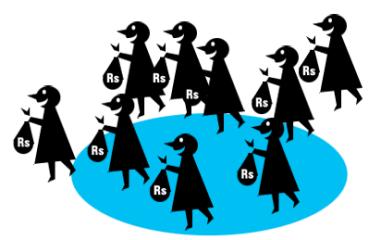 | « Back to article | Print this article |
How to retire rich? Invest Rs 3,980 per month
If you want to become rich, it is not too difficult. Here are some tips by P V Subramanyam, author of Retire Rich: Invest Rs 40 a Day.
The question to ask is not how much should I be saving. Instead the question should be: How much should I be investing?
When it comes to saving and investing, people are obsessed with the returns on their money. Whether it's debating the merits of a particular investment strategy, discussing the pros and cons of insurance, pensions and mutual funds (or increasingly unit linked plans) or simply searching for the best interest rate on bank deposits, it's the returns that dominate people's thinking.
This is perhaps the main reason that people choose National Savings Certificates, PPF, and other 'guaranteed' return products.
This is perfectly alright, because, the better the returns you get, the more money you'll end up with. There are two more factors that determine how much money we end up with: the amount we put into our investments in the first place and the amount of time we have it there.
These two factors will have a far greater impact on how much money you end up with than mundane things like investment returns.
For instance, let's suppose that you need to cobble together Rs 5 crore over 40 years (you are 25 now and plan to retire by 65) and you reckon on getting an investment return of 12 per cent per year. If you pop the numbers in to excel, you'll see that you have to save a paltry looking Rs 3,980 per month. For a person with Rs 25,000 take home salary, putting away Rs 130 a day is not difficult, correct?
Subra also runs a blog: www.subramoney.com.
You can buy Subra's book here: Retire Rich: Invest Rs 40 a Day
How you can make it difficult
Now imagine that you spend an extra ten years of your life on the spending mode and you find yourself with just 30 years to get Rs 5 crore together.
At the same 12 per cent per year investment return, you'll now have to save a difficult Rs 14,000 per month: More than three times the monthly amount, although you have only 10 years less to make your money grow to Rs 5 crore now.
What if we did fancy ourselves to get that higher investment return, which would surely get us to our Rs 5 crore, over 20 years, with 12 per cent per annum returns? Well then you will have to invest Rs 44,000. This is not really a breeze now.
But what if you get a higher rate of return instead of the assumed 12 per cent to reach your target in less time?
Well, of course anything's possible, but to make up for the missed time, you'll have to almost double your investment returns. In fact, you'd need to get a return of 21 per cent per year to hit your target with Rs 3,980 in 20 years! Not really easy you see!
Click NEXT to read more
Putting in your own numbers
Have a play on many calculators available on the net with your own numbers. You will come to the numbers that you should be doing.
Finally, you'll also need to account for your investing costs. If you're investing in the stock market via an index fund, then your investment cost might amount to one per cent per year. If you're investing via an actively-managed investment fund, then your charges might be more like 2.5 per cent.
So, for an efficient, indexing strategy, you'd want to use a figure of 9 per cent to 15 per cent. It would certainly be easier to argue for a figure of 9 per cent per year than 12 per cent per year.
With so little to play with, it's no accident that shares are considered better long-term investments than cash and gilts and it's no accident that low-cost cash tend to work best.
Click NEXT to read more
So, plug everything in...
You should now have a investment return to aim for, an amount that you need to reach. All you need to do now is have a realistic guess at how many years you have until retirement, plug in the numbers and hey presto, it'll tell you how much you need to save.
...and repeat the process regularly
It's important to know that these calculations only tell you what to do, based on certain assumptions. Those assumptions are guesses at best and they'll change regularly. The investment return you get might be different from predicted and the date of your retirement might get closer or further away.
Most importantly, since we're saving money in today's value, we'll have to keep increasing the amount we save to take account of inflation and average earnings growth.
Let's go back to the original example where we were expecting a return of 12 per cent per annum and aiming to cobble together Rs 5 crore over 40 years. To do that we had set about saving Rs 3,980 per month. Now let's fast-forward to 2015 (five years from the start) and look at two possible scenarios: one good and one not so good.
Click NEXT to read the good and bad scenarios
Scenario 1: Things go fine!
In the first scenario, we've actually managed an excellent investment return of 22 per cent per year. That gives us a pot of investments Rs 450,000 worth (at the end of 2015). The investment return is all the more impressive because banks would have paid you much lesser!
Plugging the numbers in (a final value of Rs 5 crore, 35 years to get there, Rs 4.5 lakh already invested and a 12 per cent annual return), we find we need to save Rs 3,500 per month to get us there! That's a paltry fall of Rs 480 (Rs 3,980 minus Rs 3,500) per month!
In spite of the fact that we have got a cracking 22 per cent per annum the amount that we should be investing falls by such a small sum. Again keeping a conservative mindset you should keep the investment amount constant.
Scenario 2: Things go not so well
In the second scenario, we've actually managed an investment return of 10 per cent per year. That gives us a pot of investments worth Rs 325,000. Plugging in the numbers for this scenario we find that we need to set aside Rs 4,800, again just a little more (Rs 4,800 minus Rs 3,980 = Rs 820) than what we have been investing so far.
So really have things got harder for us because of the poor investment return that we managed? No. Our income has gone up much more (assuming you salary increases in the intervening five year period), so paying this extra Rs 820 is now a breeze! Should you increase the investment? Yes absolutely.
Click NEXT to read more
Either way, it's better than doing nothing
The gap between 22 per cent and 10 per cent is not small, is it? The impact is subdued because of the time frame that we are looking at -- the impact is marginal. So the rate of return though, important, is not the be all and end all of investing.
So, by repeating the sums on a regular basis, you can adjust your rate of investing to account for changing circumstances and how well your investments have actually done. Ideally, you should probably refresh the rate at which you're adding to your savings and investments on a yearly basis.
Anyway, what you can see from both the scenarios above is the importance of getting started early. Where things had worked well for the first five years, you'd be left looking to invest Rs 3,500 per month. Where things had gone badly, you'd be left saving Rs 4,800.
So get investing now!





